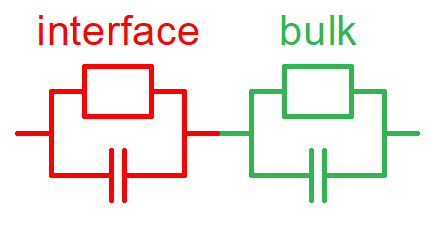

In electronic conductors, electrons (or holes) can localize due to disorder. Disorder may arise from an amorphous structure (e.g., amorphous Si), from doping (substitutional disorder), or even occur in nominally pure crystals due to slight deviations from stoichiometry or lattice imperfections. Charge transport of localized charge carriers takes place via hopping conductivity, which leads to a characteristic signature in the frequency dependence of the complex conductivity and is the most common conductivity mechanism in condensed matter. We are especially interested in the role of charge-carrier localization in the so-called Mott-Hubbard insulators and in metal-insulator transitions, occurring in various materials depending on doping, temperature or magnetic field. In addition, information on the nature of the charge carriers (e.g., polarons) and transport mechanisms (thermally activated, tunnelling,...) can be gained by dielectric spectroscopy. Some examples of publications from our group in this field are:
|
P. Lunkenheimer, A. Loidl, C.R. Ottermann, and K. Bange, Phys. Rev. Lett. 44, 5927(R) (1991). [PDF] |
|
P. Lunkenheimer, M. Resch, A. Loidl, and Y. Hidaka, Phys. Rev. Lett. 69, 498 (1992). [PDF] |
|
A. Seeger, P. Lunkenheimer, J. Hemberger, A.A. Mukhin, V.Yu. Ivanov, A.M. Balbashov, and A. Loidl, J. Phys.: Cond. Matter 11, 3273 (1999). |
|
P. Lunkenheimer and A. Loidl, Phys. Rev. Lett. 91, 207601 (2003). [PDF] |
|
P. Lunkenheimer, T. Rudolf, J. Hemberger, A. Pimenov, S. Tachos, F. Lichtenberg, and A. Loidl, Phys. Rev. B 68, 245108 (2003). [PDF] |
|
S. Krohns, P. Lunkenheimer, S.G. Ebbinghaus, and A. Loidl, J. Appl. Phys. 103, 084107 (2008). [PDF] |
Known mainly from dipolar glassforming liquids, typical relaxation features can also occur in the dielectric spectra of electronic conductors. Examples:
a) Maxwell-Wagner Relaxations

Non-intrinsic effects like the long-known Maxwell-Wagner polarization can give rise to relaxation-like features in electronic conductors. For example, they can arise when Schottky diodes form at the interface between metallic contacts and a semiconducting sample. This can lead to apparently "colossal" values of the dielectric constant. Such effects are often mistaken for intrinsic contributions and have to be excluded making suitable experiments. Some relevant papers from our group:
|
P. Lunkenheimer, V. Bobnar, A.V. Pronin, A.I. Ritus, A.A. Volkov, and A. Loidl, Phys. Rev. B 66, 052105 (2002). [PDF] |
|
P. Lunkenheimer, R. Fichtl, S.G. Ebbinghaus, and A. Loidl, Phys. Rev. B 70, 172102 (2004). [PDF] |
|
S. Krohns, P. Lunkenheimer, S.G. Ebbinghaus, and A. Loidl, Appl. Phys. Lett. 91, 022910 (2007). [PDF] |
|
S. Krohns, P. Lunkenheimer, Ch. Kant, A.V. Pronin, H.B. Brom, A.A. Nugroho, M. Diantoro, and A. Loidl, Appl. Phys. Lett. 94, 122903 (2009). [PDF] |
|
P. Lunkenheimer, S. Krohns, S. Riegg, S. G. Ebbinghaus, A. Reller, and A. Loidl, Eur. Phys. J. Special Topics 180, 61 (2010). |
|
S. Krohns, P. Lunkenheimer, S. Meissner, A. Reller, B. Gleich, A. Rathgeber, T. Gaugler, H.U. Buhl, D.C. Sinclair, and A. Loidl, Nature Mater. 10, 899 (2010). |
|
S. Emmert, M. Wolf, R. Gulich, S. Krohns, S. Kastner, P. Lunkenheimer, and A. Loidl, Eur. Phys. J. B 83, 157 (2011). |
b) Orbital Glass
In certain materials, electronic orbitals, dumbbell-shaped clouds of electrons around an atom, can freeze in a glass-like fashion, which, via electron-lattice coupling, can lead to relaxation features in the dielectric spectra. This "glassy freezing" of orbital motion exhibits typical characteristics known from canonical glasses. However, amazingly upon cooling here electronic degrees of freedom slow down, becoming as slow as 0.1 s, while usually electrons are known to exhibit much faster dynamics (in the order of 10-15s). In this way, a novel state of matter, an "orbital glass", is formed at low temperatures. See:
|
R. Fichtl, V. Tsurkan, P. Lunkenheimer, J. Hemberger, V. Fritsch, H.-A. Krug von Nidda, E.-W. Scheidt, and A. Loidl, Phys. Rev. Lett. 94, 027601 (2005). [PDF] |
|
A. Loidl und P. Lunkenheimer, J. Non-Cryst. Solids 351, 2793 (2005). |
|
R. Fichtl, P. Lunkenheimer, J. Hemberger, V. Tsurkan, and A. Loidl, Physik in unserer Zeit 36, 112 (2005). |
(see also: Physics Today, March 2005, p. 9)
c) Polarons
It is known that local motions of polarons or other localized charge carriers can lead to relaxational behaviour.
If measured in a sufficiently broad frequency range, all non-metallic disordered matter - including doped semiconductors - seems to reveal a universal dielectric behaviour, i.e. the frequency dependence of the conductivity and dielectric constant of very different materials behaves qualitatively astonishingly similar. See:
|
P. Lunkenheimer and A. Loidl, Phys. Rev. Lett. 91, 207601 (2003). [PDF] |

In highly anisotropic,
approximately one-dimensional materials, a charge density wave (CDW) can
form. Here the charge density is a periodic function of position and its
period can be incommensurate with the crystal lattice. The dielectric
behaviour of CDW systems shows two characteristic features: A
harmonic-oscillator mode at GHz frequencies, caused by the CDW being pinned at
defects, and a huge relaxation mode at kHz-MHz involving extremely large
values of the dielectric constant, whose true origin is not completely
clarified. An investigation of a CDW-related material
showing colossal dielectric constants can be found in:
D. Starešinic, P. Lunkenheimer, J. Hemberger, K. Biljakovic, and A. Loidl,
Phys. Rev. Lett. 96, 046402 (2006).
[PDF]
The dynamics of free charge carriers, e.g., metallic electrons or electrons in the conduction band of semiconductors can lead to a characteristic frequency dependence of the complex conductivity. This is mainly investigated in the submillimeter and infrared region. For so-called heavy-fermion materials, where the electrons have very high effective masses, this dynamics can also be detectable in the microwave range or at even lower frequencies.